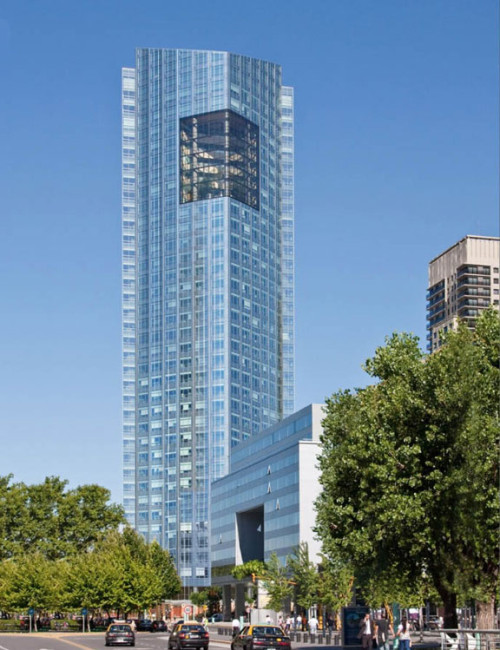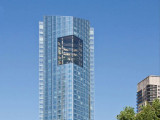Height rank
Torre Repsol YPF
Buenos Aires
-
Metrics
You must be a CTBUH Member to view this resource.
Official Name
Torre Repsol YPF
Other Names
Torre YPF
Type
Building
Status
Completed, 2008
Country
City
Address
Postal Code
1106
Function
A mixed-use tall building contains two or more functions (or uses), where each of the functions occupy a significant proportion of the tower's total space. Support areas such as car parks and mechanical plant space do not constitute mixed-use functions. Functions are denoted on CTBUH "Tallest Building" lists in descending order, e.g., "hotel/office" indicates hotel function above office function.
office
Structural Material
Both the main vertical/lateral structural elements and the floor spanning systems are constructed from steel. Note that a building of steel construction with a floor system of concrete planks or concrete slab on top of steel beams is still considered a “steel” structure as the concrete elements are not acting as the primary structure.
Reinforced Concrete
Both the main vertical/lateral structural elements and the floor spanning systems are constructed from concrete which has been cast in place and utilizes steel reinforcement bars.
Precast Concrete
Both the main vertical/lateral structural elements and the floor spanning system are constructed from steel reinforced concrete which has been precast as individual components and assembled together on-site.
Mixed-Structure
Utilizes distinct systems (e.g. steel, concrete, timber), one on top of the other. For example, a steel/concrete indicates a steel structural system located on top of a concrete structural system, with the opposite true of concrete/steel.
Composite
A combination of materials (e.g. steel, concrete, timber) are used together in the main structural elements. Examples include buildings which utilize: steel columns with a floor system of reinforced concrete beams; a steel frame system with a concrete core; concrete-encased steel columns; concrete-filled steel tubes; etc. Where known, the CTBUH database breaks out the materials used in a composite building’s core, columns, and floor spanning separately.
concrete
Height
160.0 m / 525 ft
Floors Above Ground
36
Floors Below Ground
3
# of Elevators
12
Tower GFA
75,112 m² / 808,499 ft²
-
By function
You must be a CTBUH Member to view this resource.
-
By material
You must be a CTBUH Member to view this resource.
Architect
Usually involved in the front end design, with a "typical" condition being that of a leadership role through either Schematic Design or Design Development, and then a monitoring role through the CD and CA phases.
Structural Engineer
MEP Engineer
Other Consultant
Other Consultant refers to other organizations which provided significant consultation services for a building project (e.g. wind consultants, environmental consultants, fire and life safety consultants, etc).
Other Consultant refers to other organizations which provided significant consultation services for a building project (e.g. wind consultants, environmental consultants, fire and life safety consultants, etc).
You must be a CTBUH Member to view this resource.
Developer
Repsol YPF
Architect
Usually involved in the front end design, with a "typical" condition being that of a leadership role through either Schematic Design or Design Development, and then a monitoring role through the CD and CA phases.
Structural Engineer
MEP Engineer
Other Consultant
Other Consultant refers to other organizations which provided significant consultation services for a building project (e.g. wind consultants, environmental consultants, fire and life safety consultants, etc).
Other Consultant refers to other organizations which provided significant consultation services for a building project (e.g. wind consultants, environmental consultants, fire and life safety consultants, etc).
These are firms that consult on the design of a building's façade. May often be referred to as "Cladding," "Envelope," "Exterior Wall," or "Curtain Wall" Consultant, however, for consistency CTBUH uses the term "Façade Consultant" exclusively.
Vidaris, Inc.
Vidaris, Inc.
About Torre Repsol YPF
With its prismatic form, clean lines and dramatic winter garden, the new headquarters for Repsol-YPF—one of the world’s top energy companies—is a dignified corporate symbol and a modern landmark for Buenos Aires. The tower is also the tallest office building in Argentina.
The Torre YPF stands apart from the busy streets and avenues of Buenos Aires, its full height visible from all sides. Located on the edge of the stylish neighborhood of Puerto Madero and visible from the historic Plaza de Mayo, the tower is the easternmost structure before the open space of Costanera Sur (the Buenos Aires ecological reserve) and the broad waters of the Rio de la Plata.
The tower’s form is composed of two volumes generated from the interlocking shapes of a triangle and a square, rotated 45-degrees from one another and extruded skyward. The result is two distinct towers pressed together in a single, unified composition. The floor plates of each tower press outward in a gentle curve, causing the glass-and-steel skin to appear stretched across the building’s surface and heightening its delicate sense of thinness.
While the two interlocking towers share an aesthetic spirit, they are subtly differentiated. The triangular tower, reminiscent of a ship’s prow, tilts toward the river, while the square tower leans toward the city. The triangular tower is nearly all glass and has a lightly reflective finish and fine pattern of horizontal lines that accentuates its sense of volume. The square tower, on the other hand, has a more urban expression, with a grid of stainless steel panels surrounding square panels of glass.
The tower’s most distinctive feature is its six-story winter garden, located in the corner of the square tower near, but not quite at, the top. The winter garden has an emblematic presence on the façade, like a logo or a sign. Several large trees occupy the space, and at night, lit from within and visible from afar, the winter garden is a symbol for clean energy and Buenos Aires’ natural setting.
Subscribe below to receive periodic updates from CTBUH on the latest Tall Building and Urban news and CTBUH initiatives, including our monthly newsletter. Fields with a red asterisk (*) next to them are required.
View our privacy policy


